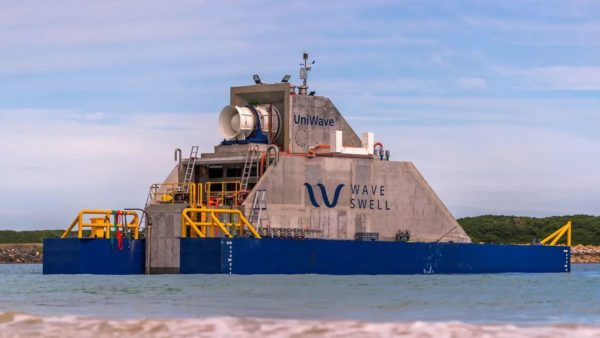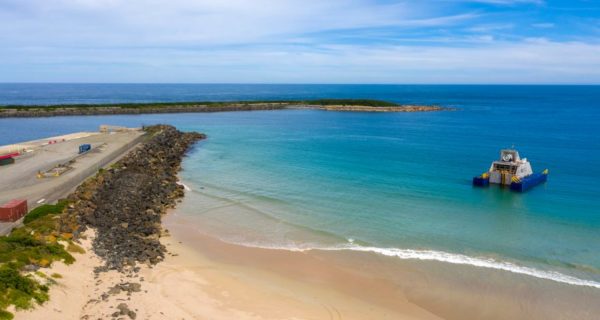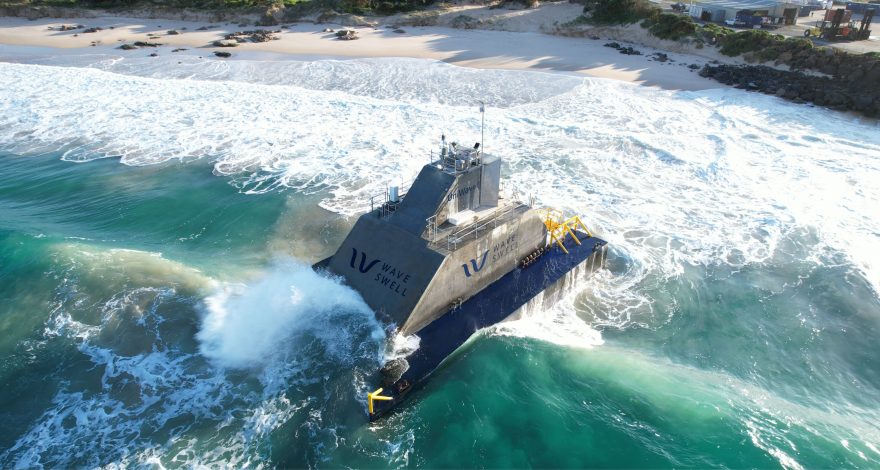Melbourne-based Wave Swell Energy (WSE) said the trial of its UniWave200 wave energy converter off the coast of Tasmania’s King Island had exceeded expectations with the test platform achieving conversion rates of up to 50% while supplying constant power to the island’s hybrid microgrid for a full 12 months.
WSE partnered with local utility Hydro Tasmania on the pilot project, integrating its 200 kW UniWave wave power unit – a boat-like platform that uses an artificial blowhole formation to create air pressure changes that drive a turbine – with a hybrid microgrid that supplies more than two thirds of the island’s energy needs through a combination of wind, solar PV and batteries.
The test platform was installed last year in the waters of Grassy Bay, on King Island’s south-east coast. The platform is partly submerged in about six metres of water about 100 metres offshore. From there, it has been contributing clean energy to the island’s microgrid for 12 months, supplying up to 200 kW of renewable energy around the clock.
WSE chief executive officer Paul Geason said the trial had proven the capabilities of the technology and in some cases had exceeded the company’s expectations.
“We set out to prove that Wave Swell’s wave energy converter technology could supply electricity to a grid in a range of wave conditions, and we have done that,” he said. “In some instances, the performance of our technology in the ocean has exceeded expectations due to the lessons we’ve learned through the project, technological improvements, and the refinements we have made over the year.”

Image: Wave Swell Energy
The UniWave device uses an oscillating water column design which essentially mimics a natural blowhole. Wave swells force water into a chamber beneath the waterline, pressurising the air and forcing it to pass through a turbine at the top of the chamber. This power is converted into electricity that can be fed into the grid.
WSE said previous oscillating water column designs have all been bidirectional whereas the UniWave device operates unidirectionally, resulting in the turbine being simpler, more robust and reliable, and exhibiting a higher energy conversion efficiency.
Geason said the 200 kW test platform had achieved a rate of conversion from wave power to grid-compliant electricity at an average of 45 to 50% in a wide range of wave conditions.
“The conversion rates that we’ve been able to achieve in terms of the amount of electricity we are able to extract from the wave energy that comes into the unit is very high,” he said. “This is a vast improvement on past devices and shows that the moment has arrived for wave power to sit alongside wind, solar and energy storage as part of a modern energy mix.”
WSE said under the right wave conditions the 200 kW test platform is capable of generating enough energy for 200 homes.
“It’s important to stress that the demonstration at King Island was not about producing high volumes of electricity,” Geason said.
“Rather, it was to prove the capabilities of our technology in a variety of wave conditions. The results have met and at times exceeded our expectations. As an example, when the unit is generating 40 kW of power in reasonable wave conditions, you could extrapolate the amount of energy to be in the order of 1 MWh in a 24-hour period.”

Image: Wave Swell Energy
While wave energy has not seen the cost reductions or widespread deployments that other renewable technologies have enjoyed, WSE is confident the technology will in time compete with wind and solar on cost, and said it has the added advantage of being more predictable and consistent.
The King Island platform is expected to remain in place at least until the end of 2022, and the company is now looking to commercialise the technology, having already attracted interest from Europe, the United States and India.
WSE said the 200 kW pilot can be scaled up to a 1 MW design and placed off any coastline anywhere in the world. The units can also be integrated into sea walls or breakwaters.
“Now we find ourselves in a position where we’ve proven the technology and the next stage is now to move forward and commercialise the technology and see it become mainstream as part of the global mix of renewable energies,” Geason said.
“In terms of the commercial scale-up … it will most likely be a bigger unit, and also have a bigger engine, so at least five times bigger.”
This content is protected by copyright and may not be reused. If you want to cooperate with us and would like to reuse some of our content, please contact: editors@pv-magazine.com.









I admire the simple yet clever concept and the improvement in efficiency is superb. Well done WSE. The problem with wave energy is at a higher level and fundamental: the places where it can be used are one-dimensional, being coastlines, and social licence will expire very quickly. Compare with solar which works pretty much anywhere (two dimensional) and wind which works in widely ranging conditions due to modern turbine designs (also two dimensional and not limited to ridge lines). I like the technology but I like the beach more. The Australian Wave Energy Atlas (2018) shows the best prospects are southern or western coasts (not surprising) and matching these to existing grid gives an idea where it could get minimum $/MWh. But it’s likely that other areas might give more valuable output due to being complimentary to wind and solar – not addressed in the Atlas. Are there studies on how best to integrate wave energy with major and islanded grids?